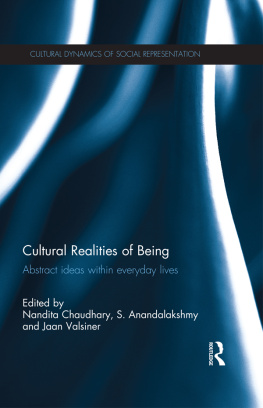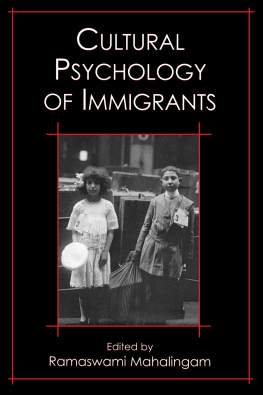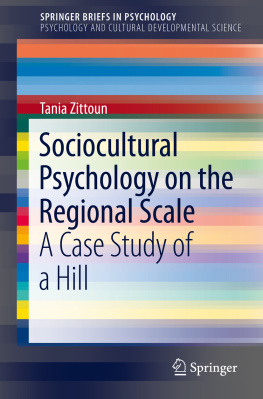Contents
An Invitation to Cultural Psychology
SAGE has been part of the global academic communitysince 1965, supporting high quality research and learningthat transforms society and our understanding of individuals,groups, and cultures. SAGE is the independent, innovative,natural home for authors, editors and societies who shareour commitment and passion for the social sciences.
Find out more at: www.sagepublications.com
An Invitation to Cultural Psychology

SAGE
- Los Angeles
- London
- New Delhi
- Singapore
- Washington DC
SAGE Publications Ltd
1 Olivers Yard
55 City Road
London EC1Y 1SP
SAGE Publications Inc.
2455 Teller Road
Thousand Oaks, California 91320
SAGE Publications India Pvt Ltd
B 1/I 1 Mohan Cooperative Industrial Area
Mathura Road
New Delhi 110 044
SAGE Publications Asia-Pacific Pte Ltd
3 Church Street
#10-04 Samsung Hub
Singapore 049483
Jaan Valsiner 2014
First published 2014
Apart from any fair dealing for the purposes of research or private study, or criticism or review, as permitted under the Copyright, Designs and Patents Act, 1988, this publication may be reproduced, stored or transmitted in any form, or by any means, only with the prior permission in writing of the publishers, or in the case of reprographic reproduction, in accordance with the terms of licences issued by the Copyright Licensing Agency. Enquiries concerning reproduction outside those terms should be sent to the publishers.
Library of Congress Control Number: 2013952465
British Library Cataloguing in Publication data
A catalogue record for this book is available from the British Library
ISBN 978-1-4462-4877-5
ISBN 978-1-4462-4878-2 (pbk)
Editor: Michael Carmichael
Editorial assistant: Keri Dickens
Production editor: Imogen Roome
Marketing manager: Alison Borg
Cover design: Wendy Scott
Typeset by: C&M Digitals (P) Ltd, Chennai, India
Printed in India at Replika Press Pvt Ltd
Preface
This book is not meant to persuade anybody to become converted to the new direction within psychologycultural psychology. One role I have always resistedand viewed with a grain of ironyis the effort of many social scientists of our time to write popular books that are intended to persuade that their viewpoint is to be accepted by interested audiences. Instead, this book is a tool for developing new ways of viewing the phenomenonall subsumed under the generic label culture. As readers will almost immediately discover, culture cannot be defined in less than in around 200 ways. Why, then, create a new discipline at the borderlines of psychology and that ephemeral notion of culture?
A number of reasons for such an undertaking can be mentioned. Globalization brings together human beings who at first glance seem to understand one anotherand, at a second, blatantly fail to do so. New closeness leads to new misunderstandingsand, at times, to new conflicts. Culture becomes an easy label for explaining such new developments. After my neighbor has passed by me, failing to greet me, I feel better if I can say to myself it is in her culture that greeting your neighbor is not accepted, rather than assume that she is afraid of the evil eye I might cast upon her.
Cultural psychology has become increasingly popular in the past two decades. There are a number of trends in contemporary cultural psychology. I do not try to overview these herethey are represented elsewhere (Valsiner, 2012b, and in the journal Culture & Psychology). In this book I merely make an effort to outline the realm of interests of one version of that new direction, cultural psychology of semiotic dynamics. It is a sequel to my 2007 book Culture in Minds and Societies (New Delhi: Sage). There is a new feature in the present bookan enhanced use of visual and literary, often metaphoric, messages to elaborate my primarily abstract theoretical ideas. Behind the myriad of examples is a structure of theoretical notions that is slowly taking its form, as the discussion wanders along.
A number of friends and colleagues have been generously helpful in the rather long process of my writing this book. Kenneth R. Cabell took great care of giving me substantive feedback on each and every chapter, which was most helpful. Pina Marsico and Raffaele DeLuca Picione found an Italian publisher and undertook the translation of some parts of the manuscript while I was frantically trying to write other parts. The enthusiastic interest by student groups in Salvador, Bahia, and Brasilia, where some of the drafts of the chapters were discussed in seminars, kept up my motivation to plough on with my writing. I am deeply indebted to all.
The book is also a marker of a transition in the authors academic life course. After 32 years of living in North America, I am in the process of moving back to Europe, with all the positive learning that the New World has given me. This includes years of creative discussions with my colleagues, first in North Carolina (Robert Cairns and Gilbert Gottlieb) and for the last 17 years at Clark University in Massachusetts. Among my colleagues at Clark, Nick Thompson, Michael Bamberg, and the intellectually ever-young Roger Bibace deserve my special gratitude. They made it possible for me to grow during the Clark years, while, unfortunately, witnessing the gradual erosion of a historically major scholarly institution. Clark University was in the pastand still isa remarkable context of higher education where all levels of scholarship, from a freshman undergraduate to an emeritus professor, can productively intermingle. My students over the yearsundergraduate and graduatehave taught me much, and have found their own ways in academia. The work of many of them is relevant to this book. The constant coming and going of international visitors to work with me and my students at Clark created the unique intellectual atmosphere of the Kitchen seminars, where good-quality coffee and the mutual respect of participants led to a variety of new ideas, including those presented in this book. My role in these seminars was to pour out the coffee and to listen. Listening has the advantage of giving us time to contemplate. It is only later, in this (and other) books, where my silence in interaction is brokenhopefully, with a bit of substance in the results.
I hope to bring back to Europe some of my acquired restless eagerness, which is known to characterize the ways of being in the Americas, and to unite that with the European tradition of intellectual depth. Special gratitude here goes to the Danish Ministry of Science and Technology, and to Aalborg University, where the new Niels Bohr Professorship Centre that we are establishing promises to open new horizons for cultural psychologys international visibility. Behind that success is the quiet and persistent effort by my colleagues in AalborgBrady Wagoner and Christian Jantzenwhose actions at the decisive moment made this all possible. I hope that the new Centre will play a catalyzing role for the many cultural-historical researchers I have met and befriended in Denmark in general. Denmarkat the border zone of Scandinavia and Central Europehas since Sren Kierkegaard retained its fierce feeling of autonomy and high educational standards. My semiotic perspective should fit well with the cultural phenomenological perspectives that are well developed in Denmark. It will, hopefully, become a fruitful basis for the future growth of ideasbeyond this book. The bookas it leaves its author and enters the realm of readability anywhere in the worldremains an effort to make sense of some very general aspects of our being human.













